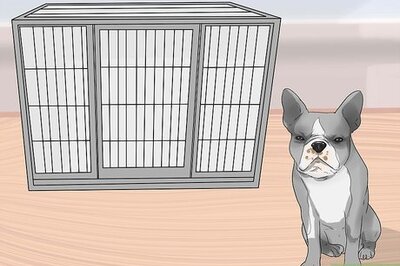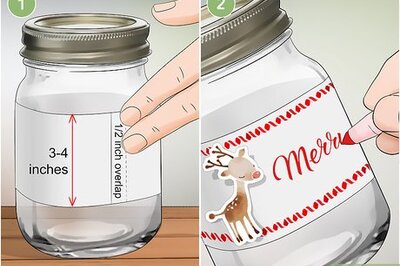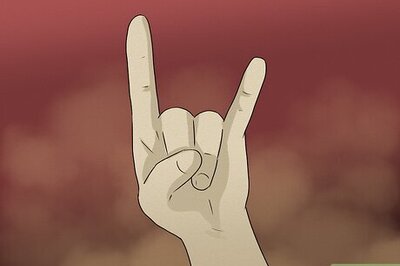
views
Different Types of Face Piercings
Septum Piercing Septum piercings dangle outside of the middle of the nose. This piercing is incredibly versatile and can even be hidden once healed. A septum piercing can also have a soft or edgy vibe depending on the style of jewelry worn. Piercing process: Typically, a 16G or 18G hollow piercing needle is inserted between the nostrils. Healing time: 1 to 3 months Recommended jewelry: Horseshoe rings, circular barbell, segment rings Pain scale: 2/5 Get advice from other wikiHow readers on the “What do I need to know before getting a septum piercing?” forum page.
Lip Piercing Lip piercings can be placed practically anywhere on the lip! The upper, lower, and center of the lip are the most common placements. Some opt for a piercing on either side of the lip for a more symmetrical, vampy look. Studs and hoops can be worn with lip piercings, but hoops can make it more difficult to eat or talk. Piercing process: Typically, a piercer will hold the skin with a surgical clamp and use a hollow piercing needle to pierce the skin. Healing time: 2 to 4 months Recommended jewelry: Studs, hoops Pain scale: 3/5
Nostril Piercing Nostril piercings are the most popular style of facial piercing. This piercing typically goes in the crevice of the nostril just below the top of the nose. They can be styled in many ways, with smaller studs giving a softer, muted look and large hoops providing an edgier vibe. Piercing process: An 18G or 20G piercing needle is inserted into the nose, or a piercing gun is used. Healing time: 2 to 8 months Recommended jewelry: L-bend, nose hoop, nose stud, nose screw, nose bone Pain scale: 1/5 EXPERT TIP Karissa Sanford Karissa Sanford Body Piercing Specialist Karissa Sanford is the Co-owner of Make Me Holey Body Piercing, a piercing studio based in the San Francisco Bay Area that specializes in safe and friendly body piercing. Karissa has over 10 years of piercing experience and is a member of the Association of Professional Piercers (APP). Karissa Sanford Karissa Sanford Body Piercing Specialist There’s no correct or wrong side to pierce your nose. It all depends on what your vision is! Piercers often suggest piercing the side where you take the most selfies or part your hair on.
Bridge Piercing Bridge piercings go across the bridge of the nose, bringing attention to the eyes and upper part of the face. This piercing has an bold, serious vibe and works best for those with thin noses. Piercing process: Bridge piercings are typically done with a hollow piercing needle. Healing time: 8-12 weeks Recommended jewelry: Straight barbell, curved barbell Pain scale: 3/5
Eye Piercing Eye piercings or eyelid piercings are located above the eye on the eyelid. Typically decorated with a captive bead ring or curved barbell, this piercing gives off a masculine, edgy vibe. Piercing process: A pair of sterile forceps pulls the lid away from the eye, and a piercing needle is inserted through the skin. Healing time: 8 weeks Recommended jewelry: Captive bead ring, curved barbell Pain scale: 4/5
Cheek Piercing Cheek piercings are typically placed where dimples would naturally be on the cheek. Because of this, they’re also called a dimple piercing. Both sides or just one side can be pierced, and this piercing has a softer edge thanks to its cute location. Piercing process: Usually, a 14G or 16G piercing needle is inserted into the cheek. Healing time: 4 to 5 months Recommended jewelry: Labret lip rings, barbells Pain scale: 3/5
Eyebrow Piercing Eyebrow piercings are exactly what they sound like: a piercing on the brow! The most popular location for this piercing is on the outer edge of the eyebrow, but it can be placed anywhere along the brow. Eyebrow piercings are considered some of the boldest and most versatile face piercings and are best for those with prominent or fleshy brow bones. Piercing process: Typically, a 14G or 16G hollow piercing needle is inserted into the skin. Healing time: 6 to 8 weeks Recommended jewelry: Curved barbells, captive bead rings Pain scale: 2/5
Horizontal Eyebrow Piercing Horizontal eyebrow piercings are placed above the natural curve of the brow. Rather than going over the eyebrow like a traditional eyebrow piercing, this piercing goes along the edge of the brow horizontally for a more symmetrical pattern. Piercing process: A hollow piercing needle is inserted into the skin above the brow. Healing time: 6 to 8 weeks Recommended jewelry: Barbells Pain scale: 3/5
Anti-Eyebrow Piercing Also known as a teardrop, butterfly, or cheekbone piercing, an anti-eyebrow piercing sits below the eye and above the cheekbone. Because of this, a piercer will take extra care to ensure that the structure of the orbital socket and skin tissue will support the piercing. Piercing process: Either a clamp is used to hold the skin before inserting the piercing needle, or a dermal punch and taper are used to press and remove the skin before inserting the jewelry. Healing time: 6 to 8 weeks Recommended jewelry: 12-18G surface bars, straight barbells, curved barbells Pain scale: 3/5
Third Eye Piercing Also known as forehead piercings, third eye piercings are located in the center of the forehead. This facial piercing is extremely decorative, eye-catching, and whimsical. Piercing process: The skin is pinched in the middle of the forehead, and a piercing needle is inserted through the pinched skin. Healing time: 4 to 6 months Recommended jewelry: Surface barbell Pain scale: 4/5
Upper Labret Piercing Also known as a philtrum or medusa piercing, an upper labret piercing sits right above the lip in the space between the nose and upper lip. Similarly, the piercing can also be done below the lower lip—this is known as a lower labret piercing. Each style gives off a bold yet enchanting vibe. Piercing process: Typically, a 14G or 16G hollow piercing needle is inserted into the skin. Healing time: 6 to 12 weeks Recommended jewelry: Flat back labret lip ring Pain scale: 1/5
Tongue Piercing While not technically on the face, tongue piercings are considered a type of facial piercing. This piercing punctures the tongue and decorates it with studs or balls. Tongue piercings can be fun, but it’s also important to note that they can make it difficult to eat and talk. Piercing process: Typically, a 14G or 16G hollow piercing needle is inserted into the tongue. Healing time: 3 to 6 weeks Recommended jewelry: Straight barbell Pain scale: 3/5
How to Pick a Face Piercing That’s Right for You
Keep your face shape in mind. Believe it or not, the shape of your face can play a big part in how a facial piercing may look on you. Determine your face shape, and then refer to the quick guide below for which piercings will likely suit you best: Round faces: Nostril piercing, septum piercing, labret piercing Oval faces: Eyebrow piercing, septum piercing Heart-shaped faces: Cheek piercing Square faces: Labret piercings Diamond faces: Bridge piercing, nostril piercing Rectangular faces: Septum piercing, nostril piercing, labret piercing
Think about your personal style. A facial piercing can elevate your everyday look. So, take a moment to ask yourself, “What is my personal style?” Are you edgy, bohemian, or cute? Knowing what your personal style is can help you pick a piercing that’ll fit your aesthetic. For example, eyebrow piercings are considered edgier while nostril piercings are daintier.
Consider your lifestyle. Some facial piercings require more care than others. Before getting a piercing, do some research and think about how a permanent accessory might interact with your life—would it interfere or enhance it? For instance, if you’re a foodie, you might want to avoid tongue and lip piercings as they can make eating more difficult during and after healing. As another example, if you sleep on your right side, you may want to avoid eyebrow or cheek piercings on the right side of your face.
Go with your gut. At the end of the day, get whichever piercing you want—it’s your body after all! If you like the way a piercing looks and dream about getting it one day, don’t let aesthetics or symmetry interfere. Do whatever makes you happy. Want to see what a piercing will look like before getting it? Give yourself a fake facial piercing with jump rings or stickers to get a feel for it. Still unsure about what piercing to get? Take our “What Piercing Should I Get?” quiz! EXPERT TIP Karissa Sanford Karissa Sanford Body Piercing Specialist Karissa Sanford is the Co-owner of Make Me Holey Body Piercing, a piercing studio based in the San Francisco Bay Area that specializes in safe and friendly body piercing. Karissa has over 10 years of piercing experience and is a member of the Association of Professional Piercers (APP). Karissa Sanford Karissa Sanford Body Piercing Specialist Always listen to your piercer. Many piercings rely heavily on anatomy. If a piercer doesn’t feel safe giving you a piercing, it’s not because it won’t look good on you; it’s to protect you from infection, scarring, and injury.
Frequently Asked Questions
How long do face piercings take to heal? The healing time of face piercings depends on the type of piercing. Some piercings take longer to heal because of where they are on the body, especially if that area of the face moves more often. Also, your body’s natural healing time can affect how long it takes for a piercing to heal fully. So, discuss piercing aftercare with your piercer and follow their instructions closely to ensure your facial piercing heals properly. Typically, it can take a facial piercing 6 weeks to 4 months to fully heal. Professional piercer Natalie Nourick recommends waiting the full estimated healing time as “your piercing will feel healed before it's actually healed because it heals from the outside in.” So, it’s better to wait longer to ensure your piercing is fully healed.
Does getting a face piercing hurt? Yes, getting a face piercing can hurt, but not always! The pain of a face piercing depends on the type of piercing and your pain tolerance. Everyone has a different tolerance to pain, so unfortunately, you may not know how badly a piercing will hurt until you get it done. Talk to a friend who’s had a similar piercing done or chat with your piercer beforehand to see if they can give you a comparison of how much your chosen piercing may hurt.
What is the easiest face piercing to hide? The easiest face piercing to hide is a septum piercing. Once fully healed, the jewelry in a septum piercing can be swapped out and flipped to be nearly invisible. The most common way to hide a septum piercing is to wear a horseshoe and flip it into the nose.
How much do face piercings cost? Piercing prices vary depending on the type of piercing and where you’re getting it done. Typically, facial piercings cost between $30 and $100 on average. Call up piercers in your area to get an estimate before you schedule an appointment.
How much does face jewelry cost? The piercing type, style, and quality of face jewelry determine the price. Jewelry made of cheaper materials (like base metals and sterling silver) is usually the cheapest. On average, face jewelry can cost anywhere from $10 to $50.
When can you change your facial jewelry? It’s advised to only change your facial jewelry once the piercing has healed completely. Switching your jewelry before that could cause scarring or an infection. Talk to your piercer about a healing timeline. Body piercing specialist Karissa Sandford explains that “you really want your piercing to be healthy and stable before switching to a piece of jewelry that’s going to move more.”
Are there other types of face piercings? Yes! The facial piercings we mentioned in this article are only the tip of the iceberg. There are so many types of facial piercings out there. We’ve included the most popular options, but if you can imagine it, chances are it’s possible. Chat with a professional piercer to see what other piercings are available for you.




















Comments
0 comment